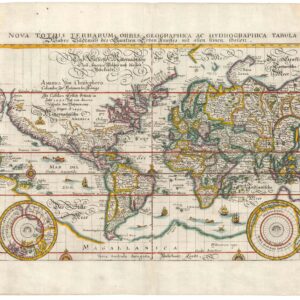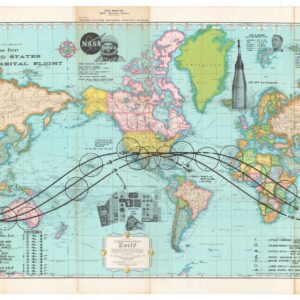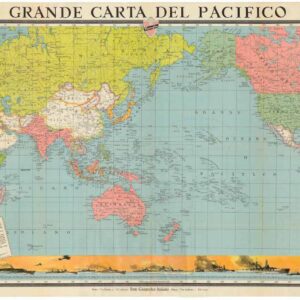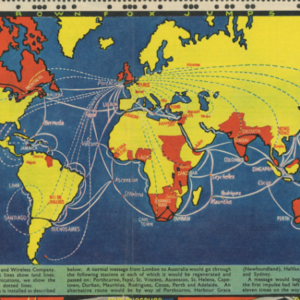An informative world map showing the diversified origins of mathematics, science, and technology.
A World of Mathematics, Science, and Technology.
$475
In stock
Description
The development of mathematics, science, and technology has never followed a strictly linear course. Throughout the ages and across the world, humankind has innovated and calculated at its own behest. This gorgeous world map is a testimony to the scientific and mathematical accomplishments of our species. As stated on the verso of the map: “A World of Mathematics, Science, and Technology is a wall-chart illustrating achievements in these fields by people and cultures throughout the world.”
The chart shows the world in a Goode homolosine projection, which is a pseudo-cylindrical, equal-area, composite projection used only for world maps. Scattered across the landmasses, we find numbered green dots ranging from 1 to 57. These refer to the plethora of small pictorial vignettes scattered around the map. Along with a short text highlighting specific contributions to the fields of mathematics, science, and technology, these serve to exemplify just how diverse the origins of human knowledge are.
It is a fascinating spread, partly because it goes beyond the traditional view of scientific development, somehow belonging to Western Civilization only. Sure, we find great European minds like Stephen Hawking, Carl Friedrich Gauss, and Eratosthenes represented on the map, and rightly so, but the chart also includes individuals not normally recognized in the pantheon of scientific advancement. Sonya Kovalevsky and her work in differential equations and mathematical astronomy, for example; or Hideki Yukawa, who predicted the sub-atomic particle meson; or the Pakistani physicist Abdus Salam, who was the first to demonstrate a connection between electromagnetism and radioactive decay.
The references are not only to great individuals. The great civilizational accomplishments that propelled the fields of mathematics, science, and technology forward are also generously noted across the map. Examples include the Yoruba people of Nigeria, whose numerical system was based on the number 20 and required complex subtractions to work; the Maoris of New Zealand, who used geothermal energy to cook their food; or the development of extensive medicinal repertoires among the indigenous peoples of the Amazon.
In sum, this wonderful map of the world takes us beyond our own horizons to reveal that our intellectual heritage was shaped by human ingenuity across the globe.
Cartographer(s):
Addison-Wesley Publishing Company is a prominent American publishing house that is specialized in education and academic literature. Established in 1942, the company has become a trusted name in educational publishing, specializing in textbooks and learning resources for various subjects and at different levels of education.
Addison-Wesley has published a wide range of acclaimed titles across disciplines such as mathematics, science, computer science, engineering, and more. Their publications have been instrumental in fostering learning and knowledge dissemination, catering to both traditional classroom settings and online learning environments.
Condition Description
Condition is good with some scuffs, pinholes and dings.
References



